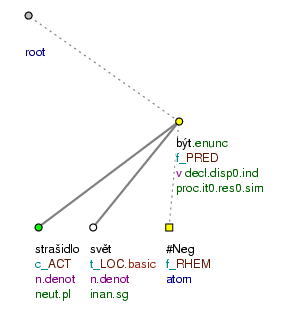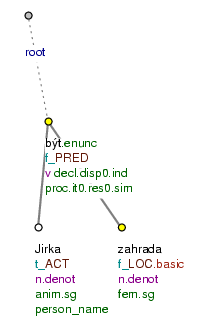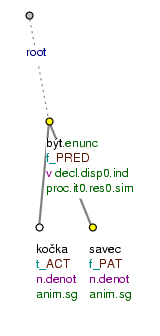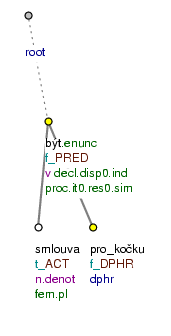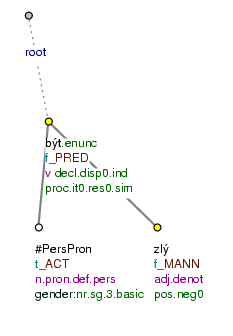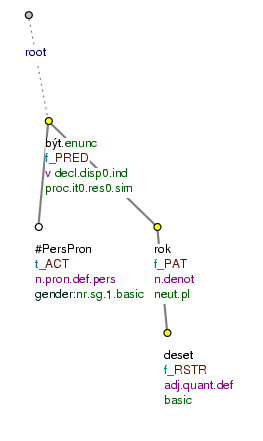For the verb být (=to be) we distinguish:
-
existential "být" (see Section 2.1.1, "Existential "být""),
-
substitute "být" (see Section 2.1.2, "Substitute "být""),
-
copula "být" (see Section 2.1.3, "Copula "být" (verbonominal predicate)"),
-
phraseological "být" (see Section 2.1.4, "Phraseological "být" (verbal idiom)").
The verb být (=to be) in single-constituent constructions is treated separately (see Section 2.1.5, ""Být" in single-constituent constructions").
As the existential být The existential verb být (=to be) is designated as meaning that "something is/is not, exists/does not exist".
The valency of existential "být". In the valency frame of existential "být" there is only an Actor. Any free modification is optional in the case of this "být".
Existential "být" expresses two meanings:
-
simple existence/non-existence of an event or a state.
Examples:
Strašidla.
ACTna světě nejsou. (=There are no ghosts in the world.) Fig. 8.12Není tu žádných chyb.
ACT(=There are no mistakes here.)Není co dělat.
ACT(=There is nothing to do.)Kdysi tu bylo na tisíce.
ACTdruhů. (=There were once thousands of species.)Je pět hodin.
ACT(=It is five o'clock.)Je poledne.
ACT(=It is noon.)Není doba.
ACTna to dělat si legraci. (=This is no time for joking.) -
the cessation of some activity or state.
Examples:
Je po zábavě.
ACT(=The party is over.)Při nedostatku motivace je po snaze.
ACT(=Where there is insufficient motivation there is no more effort.)
!!! For purposes of simplifying the annotation the valency frame for existential "být" in the meaning of simple existence/non-existence is for the time being amalgamated with the similar valency frame for substitute "být" (see Section 2.1.2, "Substitute "být"").
Substitute být is the verb být (=to be) in conjunction with some modification, where být does not signify mere existence, but stands for some full verb which can be substituted for it. This involves mainly combinations of the verb být with nouns and adjectives in cases other than the nominative and instrumental, with prepositional phrases and with adverbs.
Valency of substitute "být". Two basic groups of substitute verbs "být" are distinguished, according to the nature of the modifications (other than the Actor) with which the verb být is associated:
-
být is associated with modifications which have the character of an argument.
These are cases where the modifications of the full verb which the verb být stands for have the character of one of the arguments. These modifications are then also represented with functors for the arguments in the valency frames of the substitute "být". Cf.:
-
Rukavice.
ACTmu.PATnejsou. (=The gloves do not fit him.)The verb být is substituted in the construction for substantive verbs such as to fit, to suit, and therefore it has a frame analogous with those for Actor and Patient:
ACT(.1)PAT(.3)
It is not always possible to determine categorically for which substantive verb the verb být is substituted; in such cases the valency frames are determined intuitively.
NB! In these valency frames of the verb být the principle of shifting is applied (see Section 2.1.4, "Criteria for determining the type of argument (the principle of shifting)").
-
-
být (=to be) is associated with modifications which have the character of adjuncts.
It has been shown that the verb být can be followed by modifications with the meaning of all (ad)verbal and some (ad)nominal functors (
APP) for adjuncts.Examples:
Jirka je na zahradě.
LOC(=George is in the garden.) Fig. 8.13Úkol byl na pátek.
TOWH(The assignment was for Friday.)To je pro mě.
BEN(=That is for me.)Je pozdě.
TWHENcokoliv dělat. (=It is too late to do anything.)Vystoupení bude bez ohledu na počasí.
REG(=The performance will take place regardless of the weather.)Zájezd byl prostřednictvím kanceláře.
MEANS(=The excursion was arranged by the office.)To bylo schválně.
CAUS(=That was on purpose.)To bylo o chlup.
DIFF(=That was close.)Chaloupka je jako dlaň.
CPR(=The cottage is tiny.)Tento nástroj je na stáčení.
AIMvína. (=This instrument is for bottling wine.)Byli jsme to obhlížet.
INTT(=We have been to inspect it.)Zahrada je souseda.
APP(=The garden is the neighbour's.)NB! Modifications with the meaning of the functor
ORIGare treated here as adjuncts (similarly as with nouns - see Section 2.3.2.3.2, "Origo as a modifier of nouns"). Cf.:Nádobky jsou z plechu.
ORIG(=The bowls are of metal.)Z Evy.
ORIGje lékařka. (=Eva has become a doctor.)However, in a particular case it is not always possible to determine categorically for which substantive verb the verb být (=to be) is substituted, so as to deduce the functor of the adjunct and to determine whether the relevant modification is obligatory or optional.
!!! For the time being, therefore, a single universal valency frame, containing only the Actor, has been established for all substitute verbs "být" associated (only) with adjuncts (adjuncts are shown for this frame only as examples of typical modifications). To simplify annotation, this valency frame has been amalgamated with the similar valency frame for existential "být" signifying simple existence/non-existence (see Section 2.1.1, "Existential "být"").
NB! The verb být is followed by many adjuncts with the general meaning of a "state/condition" (on this, see Section 13.2, "Attribute with the meaning of "state""). For example:
Byla v jiném stavu.
LOC[is_state=1] (= She was "in another condition". (euphemism for pregnant))NB! If the expressions to (=that) or ono (=it) occur in these constructions, the nodes representing these expressions have the functor
INTF; for example:To.
INTFk lesu je to.ACTdaleko. (=emphatic: It is a long way to the forest.)
Copula být is the verb být which is part of a complex predicate identified with the attribute "verbonominal".
By a verbonominal predicate is meant a combination of the verb být (which in a sentence mainly carries the grammatical information) with some other word carrying the main lexical meaning of the entire complex predicate (on complex predicates see Section 9, "Multi-word predicates").
In verbonominal predicates we distinguish:
-
a verbal part.
The verbal part of a verbonominal predicate comprises a copula "být".
-
a non-verbal part.
The non-verbal part of a verbonominal predicate comprises a semantic adjective or a noun in the nominative or the instrumental. On a secondary level, the non-verbal part may also be expressed by a noun in the genitive, an infinitive, a dependent clause, an adverb or even by an interjection.
A verbonominal predicate expresses a broad spectrum of meanings: identity of Actor and Patient, qualification, classification and quantification.
Examples:
Kočka je savec.PAT (=The cat is a mammal.) Fig. 8.14
Lev je králem.PAT zvířat. (=The lion is king of the beasts.)
Jíst je obřad.PAT (=Eating is a ritual.)
Prohrát není žádnou hanbou.PAT (=There is no shame in losing.)
Je svobodným rozhodnutím.PAT , jestli pojedu. (=Whether I go is a matter of free choice.)
Jirka je hodný.PAT (=George is good.)
Byli jsme tři.PAT (=There were three of us.)
Dětí je pět.PAT (=There are five children.)
Chlapců je hromada.PAT (=There are loads of boys.)
To je moc.PAT (=That is too much.)
Památky jsou staršího původu.PAT (=The monuments are of older origin.)
Muž je vysoké postavy.PAT (=The man is tall in stature.)
Je vidět.PAT Sněžka. (=Sněžka can be seen.)
Končit není umřít.PAT (=To finish is not to die.)
Jeho výklad je, že zahrají.PAT (=According to him, they will play.)
To je fuk.PAT (=That doesn't matter.)
NB! The boundary between existential and copula "být" is sometimes associated with word order in a sentence. Cf.:
-
constructions with existential "být":
-
Je hodně problémů.
ACT(=There are lots of problems.) -
Zlí lidé.
ACTnejsou. (=There are no evil people.)
-
-
constructions with copula "být" (with a verbonominal predicate):
-
Problémů.
ACTje hodně.PAT(=There are problems in plenty.) -
Lidé.
ACTnejsou zlí.PAT(=People are not evil.)
-
Valency of copula "být". Copula "být" has in its valency frame an Actor and a Patient. Here, the Patient comprises a broad spectrum of meanings which the verbonominal predicate can express.
Representation of the verbonominal predicate. The verbonominal predicate is represented in the tectogrammatical tree by two nodes: by a node representing the verbal part of the verbonominal predicate and by a node representing the non-verbal part of the verbonominal predicate. The functor of the node representing the verbal part is determined by the function of the entire complex predicate in the sentence structure. The node is assigned a valency frame for copula "být". The node representing the non-verbal part has the functor PAT and is represented as a direct daughter of the node for the verbal part (cf. Fig. 8.14 ). The congruity of the two constituents is not reflected in any specific way (other than by the selected valency frame).
NB! Predicates like být veselý a šťastný (=to be cheerful and happy); je otcem i dědečkem (=he is a father and a grandfather) are represented as one verbonominal predicate with co-ordination (apposition) of the non-verbal parts . This is an exception, because for the other complex predicates the rule has been adopted that the dependent parts of a complex predicate are not co-ordinated (or are not in apposition) and that they are always treated as a paratactic connection of several complex predicates (with ellipsis of the governing verbal part).
On ellipsis of complex predicates see Section 12.1.1.1, "Textual ellipsis of the governing verb".
Sub-type of quasi-modal verbs. The core verbonominal predicates are complex predicates which do not carry any modal or phasal meaning (cf. the above examples). Quasi-modal verbs with a verbal part formed by the verb být (=to be) and a non-verbal part formed by a noun or an adjective with modal meaning are also treated and represented as a sub-type of verbonominal predicates (see also Section 9.2.1, "Quasi-modal and quasi-phase verbs"). For example:
být schopný.PAT (=to be capable)
být možné.PAT (=to be possible)
být povinností.PAT (=to be an obligation)
The rules described above apply to the representation of both core verbonominal predicates and the sub-type of quasi-modal verbs.
"Být" + predicative adverb. Only one specific type of quasi-modal verbs is singled out amongst verbonominal predicates (see also Section 9.2.1, "Quasi-modal and quasi-phase verbs"): combinations of the verb být with adverbials expressing modality, attitude, evaluation. Such expressions are traditionally called predicative adverbs. These expressions do not conform to the categorisation of core verbonominal predicates adopted above, in either semantic or formal terms, and they are therefore represented by distinct valency frames. The node for the non-verbal part (adverb) is assigned the previously introduced functor CPHR (not the functor PAT). The Actor of these predicates takes the form primarily of the infinitive verb.
Examples:
je nutno.CPHR (=it is necessary)
je možno.CPHR (=it is possible)
je zatěžko.CPHR (=it is difficult)
je třeba.CPHR (=it is necessary)
!!! In the case of predicative adverbs, neither the value of the grammateme sempos (nor the morphological tag) is consolidated with the value of the adverb.
Quasi-modal verbs are frequently complex control predicates (see Section 2.4.4.4, "Infinitive dependent on the verbal part of a verbonominal control predicate").
Phraseological být is the verb být (=to be), comprising the governing part of verbal idioms (see Section 8, "Idioms (phrasemes)").
By phraseological verbs "být (=to be)" is meant a combination of the verb být (=to be) with certain prepositional groups, with prepositions themselves and other constructions with phraseological meaning.
Examples:
Smlouvy jsou pro kočku.DPHR (=Treaties are worthless.) Fig. 8.15
Obavy nejsou na místě.DPHR (=Misgivings are inappropriate.)
Seznamy jsou k mání.DPHR (=Lists are available.)
Po práci byly za vodou.DPHR (=After work they were fine.)
Je na pováženou.DPHR , do jaké míry to platí. (=How far this is true is a serious matter.)
Nebude na škodu.DPHR postupovat pomalu. (=It will do no harm to proceed slowly.)
Je v obraze.DPHR (=He/She is informed)
Valency of phraseological "být". In accordance with the rules for constituting valency frames for phraseological meanings of verbs (see Section 2.2.2, "Valency frames of idiomatic expressions (phrasemes) and complex predicates") a special valency frame is established for each verbal idiom with the verb být. Cf.:
-
Student byl hned v prachu.
DPHR(=The student immediately disappeared.)The valency frame for this idiom with the verb být:
ACT(.1)DPHR(v-1[prach.S6])
Verbal idioms with the verb být are represented in the tectogrammatical tree according to the basic rules for the annotation of idioms introduced in Section 8, "Idioms (phrasemes)" (cf. Fig. 8.15).
Single-constituent constructions with the verb být (=to be) are of two types:
-
impersonal constructions with no Actor (see Section 2.1.5.1, "Impersonal usage of the verb "být""),
-
constructions of "personal experience" with an Actor in the dative (see Section 2.1.5.2, "Constructions of "personal experience" with an Actor in the dative").
Constructions with the verb být (=to be) expressing certain natural phenomena and states, external circumstances of place, time, dimension or manner are constructions in which být is used impersonally, i.e. it has no Actor.
The valency frames of the verb být are established in such cases exclusively by the relevant obligatory adjuncts. Cf.:
-
Do odjezdu bylo dlouho.
THL(=There was a long time to go before the departure.)The valency frame for this meaning of the verb být (=to be):
THL(*)
Examples:
Je horko.MANN (=It is hot.) Fig. 8.16
K lesu je daleko.EXT (=It is a long way to the forest.) Fig. 8.17
Není nejhůře.MANN (=It is not so bad.)
Je tam útulno.MANN (=It is cosy there.)
Je pod mrakem.MANN (=It is overcast.)
Je na déšť.MANN (=It looks like rain.)
NB! Only those constructions in which natural phenomena and states, external circumstances of place, time, dimension or manner are expressed by prepositional phrases and adverbs, i.e. not by nouns in the nominative, are treated as constructions with impersonal usage of the verb být, as constructions with a zero Actor. In other cases the verb "být" is existential (see Section 2.1.1, "Existential "být""). Cf.:
-
impersonal usage of the verb být (=to be):
-
Je veselo. (=People are cheerful.)
-
Je tu vlhko. (=It is damp here.)
-
-
Existential "být" :
-
Je pět hodin. (=It is five o'clock.)
-
Je poledne. (=It is noon.)
-
NB! If the expressions to (=that) or ono (=it) occur in these constructions the nodes representing these expressions have the functor INTF; for example:
To.INTF je hezky. (=The weather is nice.)
Constructions with the verb být (=to be) expressing personal experience of physical or mental states are constructions in which a noun (or pronoun) in the dative is interpreted as an Actor experiencing the expressed physical or mental state (see also Section 2.1.4, "Criteria for determining the type of argument (the principle of shifting)").
In addition to the Actor, the relevant obligatory adjunct (usually MANN), expressing the physical or mental state is also recorded in the valency frames of the verb "být". If this physical or mental state is expressed by a noun or an adjective (or a numerical expression) it is recorded in the valency frame as an obligatory Patient. Cf.:
-
Je mu.
ACTvelmi zle.MANN(=He feels very bad.)The valency frame for this meaning of the verb být (=to be):
ACT(.3)MANN(*)Cf. Fig. 8.18.
-
Je mi.
ACTdeset let.PAT(=I am ten years old.)The valency frame for this meaning of the verb být (=to be):
ACT(.3)PAT(.1)Cf. Fig. 8.19.
Further examples:
Je mu.ACT horko.MANN (He is hot.)
Je mu.ACT hej.MANN (=He is on cloud nine.)
Je mi.ACT zima.MANN (=I am cold.)
Je mu.ACT trapně.MANN (=He is embarrassed.)
Bylo mi.ACT velmi smutno.MANN (=I was very sad.)
Té.ACT není nejhůře.MANN (=She isn't too badly off.)
NB! Constructions with an Actor in the dative with the verb být must be distinguished from constructions like:
Bylo to.ACT dávno. (=It was a long time ago.)
Je tomu.ACT dávno . (=It is long ago.)
Je tomu.ACT podobně . (=It is similar to that.)
In these constructions "být (=to be)" is a substitute verb. These constructions are distinguished from constructions of "personal experience" by the fact that their actor is inanimate and the constructions do not express physical or mental states.
NB! If the expressions to (=that) or ono (=it) occur in these constructions the nodes representing these expressions have the functor INTF; for example:
Ono.INTF mu není nejlépe. (=He isn't feeling too good now.)
To.INTF je mu zle. (=He's feeling bad, then.)
